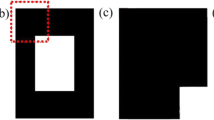Abstract
The use of mask-image-projection-based stereolithography process (MIP-SL) in additive manufacturing (AM)for 3D printing of bio-scaffold materials is becoming more widespread. In general, mask optimization, frame compensation, and resin material performance improvement were adopted to improve the curing accuracy of resin in MIP-SL process. In this paper, a mask optimization scheme based on image segmentation technology is developed, where the mask is divided into multiple little squares, hexagons, and triangles. The large-area warping deformation in MIP-SL is therefore transformed to a multiple small area distortion. Digital image correlation (DIC) method is applied to measure the effect of using mask image planning in bio-scaffolds MIP-SL process. A platform of bio-scaffolds resin shrinkage measurement based on DIC method was built to measure the resin deformation under distinct mask image planning. The results show that the deformation of the bio-scaffolds resin during the light-cured process will increase sharply at first and then tend to decrease partially. In addition, shrinkage of square segmentation and hexagon segmentation are reduced by 33% and 27%, respectively. However, the shrinkage of triangle segmentation is hardly reduced because the required time is twice as that of the other two methods.














Similar content being viewed by others
References
Ma PX (2004) Scaffolds for tissue fabrication. Mater Today 7:30–40. https://doi.org/10.1016/s1369-7021(04)00233-0
Chen L, He Y, Yang Y, Niu S, Ren H (2016) The research status and development trend of additive manufacturing technology. Int J Adv Manuf Technol 89:3651–3660. https://doi.org/10.1007/s00170-016-9335-4
Espalin D, Muse DW, MacDonald E, Wicker RB (2014) 3D printing multifunctionality: structures with electronics. Int J Adv Manuf Technol 72:963–978. https://doi.org/10.1007/s00170-014-5717-7
Huang SH, Liu P, Mokasdar A, Hou L (2012) Additive manufacturing and its societal impact: a literature review. Int J Adv Manuf Technol 67:1191–1203. https://doi.org/10.1007/s00170-012-4558-5
Melchels FPW, Domingos MAN, Klein TJ, Malda J, Bartolo PJ, Hutmacher DW (2012) Additive manufacturing of tissues and organs. Prog Polym Sci 37:1079–1104. https://doi.org/10.1016/j.progpolymsci.2011.11.007
Bikas H, Stavropoulos P, Chryssolouris G (2015) Additive manufacturing methods and modelling approaches: a critical review. Int J Adv Manuf Technol 83:389–405. https://doi.org/10.1007/s00170-015-7576-2
Gauvin R, Chen YC, Lee JW, Soman P, Zorlutuna P, Nichol JW, Bae H, Chen S, Khademhosseini A (2012) Microfabrication of complex porous tissue engineering scaffolds using 3D projection stereolithography. Biomaterials 33:3824–3834. https://doi.org/10.1016/j.biomaterials.2012.01.048
Huang YM, Jiang CP (2003) Curl distortion analysis during photopolymerisation of stereolithography using dynamic finite element method. Int J Adv Manuf Technol 21:586–595. https://doi.org/10.1007/s00170-002-1317-z
Soman P, Chung PH, Zhang AP, Chen S (2013) Digital microfabrication of user-defined 3D microstructures in cell-laden hydrogels. Biotechnol Bioeng 110:3038–3047. https://doi.org/10.1002/bit.24957
Zhang AP, Qu X, Soman P, Hribar KC, Lee JW, Chen S, He S (2012) Rapid fabrication of complex 3D extracellular microenvironments by dynamic optical projection stereolithography. Adv Mater 24:4266–4270. https://doi.org/10.1002/adma 201202024
Cha C, Soman P, Zhu W, Nikkhah M, Camci-Unal G, Chen S, Khademhosseini A (2014) Structural reinforcement of cell-laden hydrogels with microfabricated three dimensional scaffolds. Biomater Sci 2:703–709. https://doi.org/10.1039/C3BM60210A
Jariwala AS, Bourell D, Ding F, Boddapati A, Breedveld V, Grover MA, Henderson CL, Rosen DW (2011) Modeling effects of oxygen inhibition in mask-based stereolithography. RAPID PROTOTYPING J 17:168–175. https://doi.org/10.1108/13552541111124734
Sun C, Fang N, Wu DM, Zhang X (2005) Projection micro-stereolithography using digital micro-mirror dynamic mask. Sensors Actuators A Phys 121:113–120. https://doi.org/10.1016/j.sna.2004.12.011
Huang YM, Kuriyama S, Jiang CP (2004) Fundamental study and theoretical analysis in a constrained-surface stereolithography system. Int J Adv Manuf Technol 24:361–369. https://doi.org/10.1007/s00170-003-1627-9
Onuh SO, Hon KKB (2001) Improving stereolithography part accuracy for industrial applications. Int J Adv Manuf Technol 17:61–68. https://doi.org/10.1007/s001700170210
Xu K, Kwok TH, Zhao ZC, Chen Y (2017) A reverse compensation framework for shape deformation control in additive manufacturing. J Comput Inf Sci Eng 17(9):021012. https://doi.org/10.1115/1.4034874
Xu K, Chen Y (2015) Mask image planning for deformation control in projection-based stereolithography process. J Manuf Sci Eng-Trans ASME 137:12. https://doi.org/10.1115/1.4029802
Huang YM, Jiang CP (2003) Numerical analysis of a mask type stereolithography process using a dynamic finite-element method. Int J Adv Manuf Technol 21:649–655. https://doi.org/10.1007/s00170-002-1388-x
Huang YM, Lan HY (2006) Compensation of distortion in the bottom exposure of stereolithography process. Int J Adv Manuf Technol 27:1101–1112. https://doi.org/10.1007/s00170-004-2313-2
Jiang CP, Huang YM, Liu CH (2006) Dynamic finite element analysis of photopolymerization in stereolithography. RAPID PROTOTYPING J 12:173–180. https://doi.org/10.1108/13552540610670753
Watts DC (2005) Reaction kinetics and mechanics in photo-polymerised networks. Dent Mater 21:27–35. https://doi.org/10.1016/j.dental.2004.10.003
Sakaguchi RL, Wiltbank BD, Shah NC (2004) Critical configuration analysis of four methods for measuring polymerization shrinkage strain of composites. Dent Mater 20:388–396. https://doi.org/10.1016/j.dental.2003.11.002
Li J, Fok AS, Satterthwaite J, Watts DC (2009) Measurement of the full-field polymerization shrinkage and depth of cure of dental composites using digital image correlation. Dent Mater 25:582–588. https://doi.org/10.1016/j.dental.2008.11.001
Wu K, Li X, Ge Y, Ruan S (2018) Determination of tubular material parameters in bulging test with three-dimensional digital image correlation method. Int J Adv Manuf Technol 96:2091–2099. https://doi.org/10.1007/s00170-018-1598-5
Chuang SF, Chang CH, Chen TY (2011) Spatially resolved assessments of composite shrinkage in MOD restorations using a digital-image-correlation technique. Dent Mater 27:134–143. https://doi.org/10.1016/j.dental.2010.09.008
Lau A, Li J, Heo YC, Fok A (2015) A study of polymerization shrinkage kinetics using digital image correlation. Dent Mater 31:391–398. https://doi.org/10.1016/j.dental.2015.01.001
Chuang SF, Chen TY, Chang CH (2008) Application of digital image correlation method to study dental composite shrinkage. Strain 44:231–238. https://doi.org/10.1111/j.1475-1305.2007.00403.x
Blaber J, Adair B, Antoniou A (2015) Ncorr: open-source 2D digital image correlation Matlab software. Exp Mech 55:1105–1122. https://doi.org/10.1007/s11340-015-0009-1
Labella R, Lambrechts P, Van Meerbeek B, Vanherle G (1999) Polymerization shrinkage and elasticity of flowable composites and filled adhesives. Dent Mater 15:128–137. https://doi.org/10.1016/s0109-5641(99)00022-6
Funding
The study was supported by the National Natural Science Foundation of China (No. 51875214), Science and Technology Program of Guangzhou, China (No. 201804010452), and Natural Science Foundation of Guangdong Province, China (No. 2016A030311052).
Author information
Authors and Affiliations
Corresponding author
Additional information
Publisher’s note
Springer Nature remains neutral with regard to jurisdictional claims in published maps and institutional affiliations.
Rights and permissions
About this article
Cite this article
Liu, W., Deng, T., Sun, D. et al. A study of mask planning in projection-based stereolithography using digital image correlation. Int J Adv Manuf Technol 104, 451–461 (2019). https://doi.org/10.1007/s00170-019-03778-z
Received:
Accepted:
Published:
Issue Date:
DOI: https://doi.org/10.1007/s00170-019-03778-z




